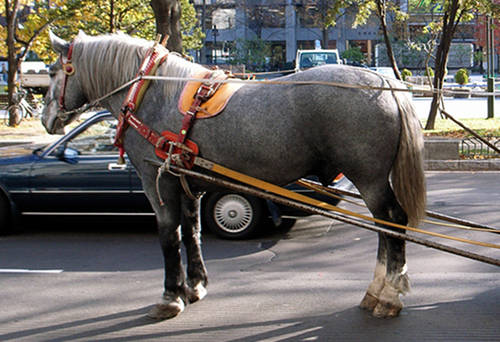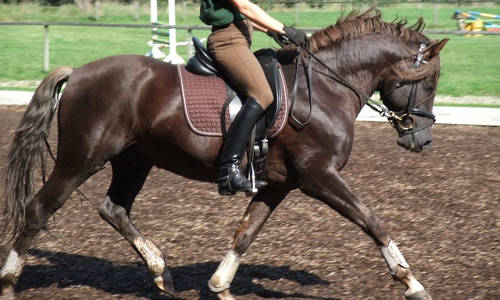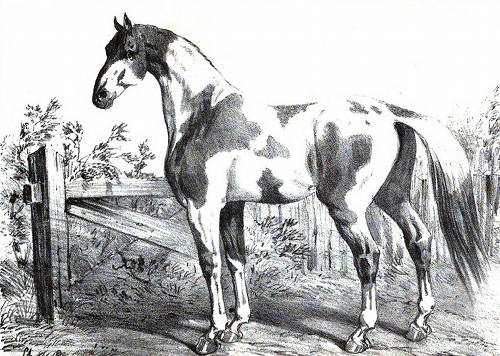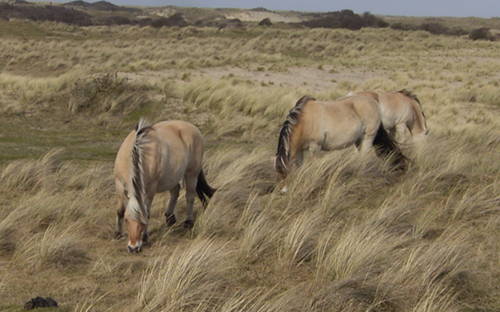Waler Horse
Country of Origin: Australia

Intro
Not an officially recognized breed, the Waler Horse is a definite type that has made themselves renowned worldwide for their hardy nature. The name Waler was coined in India in 1846 referring to the horses of New South Wales.
Origins
There are some that believe the pureblooded Waler Horses are actually extinct & that their living ancestors are the Australian Stock Horse and possibly some of the feralBrumbies. However whether through natural selection or the intervention of man, neither of these breeds resemble the Waler physically.
The first horses were taken to Australia around 300 years ago by European settlers who named their new home New South Wales. Eventually their animals became known as Walers. Their bloodlines were influenced by a variety of breeds over time including Arabian, Thoroughbred, Anglo-Arabian, Timor ponies, Clydesdale,Percheron, Suffolk Punch & Cleveland Bay. Survival in harsh Australian conditions and the periodic infusion of exotic, outside blood created a definite type, essentially all animals locally bred in Australia with obvious signs of good blood were considered Walers.
Today there are only a handful of the old Waler breed left, usually in the hands of private enthusiasts or in remote outposts.
Features
Average height 15.2 – 16 hands
Physique
There is a wide variety of confirmations, some heavier displaying draft influence & others lighter with more desert horse characteristics.
Traditional Colors
All colors
Temperament
Loyal & true
Intelligent & willing
Use
Riding horse
Military
Helpful Links
* all links open in a new window
Where to Buy
Waler Horse Studs
Video
Walkaloosa Horse

Intro
The Walkaloosa is an appaloosa horse that moves with an ambling gait, like to theSpanish Jennet. Appaloosa horses have displayed a pacing gait date back to China thousands of years ago & slowly made their way into Europe and eventually the Americas.
Origins
Appaloosas display gaits in many different places and they were originally lumped into the same category as all animals with the leopard patterns and registered asAppaloosas. However, appaloosa breeders shied away from breeding gaited animals and eventually the registry quit accepting them.
In 1983 the Walkaloosa Horse Association was formed to preserve animals with both gaits & spots. In order for an animal to qualify they have to have been born of a registered Walkaloosa, possess the leopard gene & natural gaits or be the result of an appaloosa & a gaited breed.
Features
Average height 14 – 15.2 hands
Physique
Physical confirmation will vary based on bloodlines.
Traditional Colors
Use
Riding horse
Helpful Links
* all links open in a new window
Where to Buy
Video
Washu horse/ Dosanko Horse
Country of Origin: Japan

Intro
Also called the Hokkaido Horse, the Dosanko horse comes from the Japanese island of Hokkaido. They are a revered breed in Japan and one of the most plentiful ancient Japanese pony breeds.
Origins
Descendant from the first horses brought to Hokkaido island by Korean fisherman sometime in the 15th century, and was at some point given an injection of Mongolianblood as well. This is one of Japan’s few native breeds.
The Donsanko evolved over centuries, adapting to harsh winters and tough terrain and is now a stout animal known for their hardy constitution. In 1979 a pedigree book was assembled for the breed
Features
Average height 13 – 13.2 hands
Remarkably strong for their size
Physique
Head is plain and clearly of Mongolian influence
Legs are slender & light with silky feathering
Traditional Colors
Temperament
Willing temperament
Use
Farm work in mountainous regions
Military pack animals
Heavy transport
Pleasure mount
Video
Welara Pony
Country of Origin: USA

Origins
The Welara Pony comes from a cross between Welsh Ponies & Arabian horses, and the resulting animal possesses refined beauty, intelligence & a good temperament.
Although people have been crossing these two breeds for over 75 years, this breed is relatively new. The Welara Pony Association was formed in 1981 by a group of enthusiasts to recognize & promote the breed.
Features
Average height 11.2 – 15 hands
Physique
Head is carried high with a dished profile
Traditional Colors
All colors
Temperament
Intelligent & friendly
Generous & kind
Use
Show pony
Riding pony
Helpful Links
* all links open in a new window
Where to Buy
Video
Welsh Mountain Pony (Section A)
Country of Origin: Wales

Intro
All sections of the Welsh ponies come from Wales and the Welsh Mountain Pony registers under Section A of their studbook. The Mountain pony is the original, an ancient breed that inhabited Wales prior to Roman invasion, of the four types of cobs, this is the oldest.

Origins
The mountain ponies are thought to be descendant of the Celtic ponies, however their confirmation indicates that there was some Arabian influence along the way.
4 Welsh Pony Types
Based on the blood of the mountain type, 3 other types have emerged.
Section A – Which is the mountain pony and they may not exceed 12.2 hands.
Section B – A slightly larger animal that stands 12.2 – 13.2 hands
Section C – A pony of cob type and a more robust animal standing up to 13.2 hands
Section D – The Welsh Cob which is a horse type standing 14 – 15.1 hands
Features
Average height 12.2 hands
Physique
Head is small & handsome with straight or slightly concave profile
Eyes are large
Ears are small & pricked
Neck is shapely & arched
Back is short & straight
Chest is deep & broad
Shoulder is long & sloping
Legs are sturdy with broad joints
Hooves are round & tough
Traditional Colors
All colors except pinto patterns
Temperament
Friendly & kind
Trustworthy & intelligent

Use
Riding pony
Light draft
Show pony
Harness
Welsh Pony (Section B)
Country of Origin: Wales

Intro
All sections of the Welsh ponies come from Wales and the Welsh Pony registers under Section B of their studbook. This pony breed is a larger version of the Welsh Mountain Pony which was the foundation for the breed.

Origins
This pony was created by breeding local mountain ponies with Hackney blood and that of small Thoroughbred stallion named Merlin. Because of Merlin’s strong influence over the Welsh Pony they are often called Merlins.
During various points over the years Section B of the welsh studbook has been opened to half-breeds which has helped to produce a lighter & taller pony.
Features
Average height 12.2 – 13.2 hands
Physique
Head is small & handsome with straight or slightly concave profile
Eyes are large
Ears are small & pricked
Neck is shapely & arched
Back is short & straight
Chest is deep & broad
Shoulder is long & sloping
Legs are sturdy with broad joints
Hooves are round & tough
Traditional Colors
All colors except pinto patterns
Temperament
Friendly & kind
Trustworthy & intelligent
Use
Riding pony
Light draft
Show pony
Harness
Helpful Links
* all links open in a new window
Where to Buy
Welsh Pony (Section B) Studs
Video
Welsh Pony of Cob Type (Section C)
Country of Origin: Wales

Intro
All sections of the Welsh ponies come from Wales and the Welsh Pony of Cob Type registers under Section C of their studbook. The cob type Welsh pony is essentially a smaller type of the Welsh Cob (Section D).
Origins
This pony was created by breeding local mountain ponies with Andalusian & Cobblood, creating a stockier, more robust animal. Their larger size made them useful for a wide variety of needs from farming to transport.
Features
No taller than 13.2 hands
Physique
Head is pony in type with a straight profile
Eyes are widely spaced & expressive
Ears are small
Neck is muscular, long & arched
Back is short & strong
Chest is deep & wide
Shoulder is muscular & sloping
Legs are short & strong with some feathering at the fetlocks
Feet are well formed & tough

Traditional Colors
All colors except pinto patterns
Temperament
Friendly & kind
Trustworthy & intelligent
Use
Riding pony
Light draft
Show pony
Harness
Helpful Links
* all links open in a new window
Where to Buy
Welsh Pony of Cob Type (Section C) Studs
Video
Welsh Cob (Section D)
Country of Origin: Wales

Intro
All sections of the Welsh ponies come from Wales and the Welsh Cob registers under Section D of the Welsh Pony studbook. This area has bred a horse of cob type for centuries, useful for both farm work, carriage & riding purposes.

Origins
The D Section was created from the Welsh Mountain Pony found native in Wales, bred specifically as a horse type. The exact origins of this type is a mystery, lost in the sands of time, however there has been evidence of similar animals since Medieval times. Throughout the years they have proven to be hardy, versatile and supremely useful to the people of Wales. Prior to the 20th century were one of the fastest means of transportation, however the advent of mechanized transport put them out of favor until recently.
A renewed interest in driving competitions has given the Welsh Cob a chance to shine again and a there has been a renewed interest in their bloodlines.
Features
Average height 14 – 15 hands
Physique
Head is small & well proportioned with a straight profile
Eyes are large & prominent
Ears are small & pointed
Neck is long, muscular & arched
Back is short & wide
Chest is broad & deep
Legs are short & strong with clean joints and some feathering at the fetlocks
Hooves are shapely & strong
Traditional Colors
All colors except pinto patterns
Temperament
Gentle & docile

Use
Riding horse
Light draft
Transportation
Show horse
Helpful Links
* all links open in a new window
Where to Buy
Welsh Cob (Section D) Studs
Video
Weser-Ems Pony/German Riding Pony
Country of Origin: Germany

Intro
Also called the Deutsches Reitpony & Weser-Ems Pony, the German Riding Pony is a relatively new breed that was developed as a pony with horse like characteristics and retaining a horse type. They are often described as mini warmbloods.
Origins
They were developed by crossing Welsh, Connemara, New Forest, Dulmen, Arabian& Anglo-Arabian bloodlines. The resulting pony is elegant with clean confirmation and lively action. Today they are their own breed and new blood is no longer added to their studbooks.
Features
Average height 13.2 – 14.2 hands
Physique
There is no distinct types so individual animals vary in shape & size.
Traditional Colors
Most solid colors
Temperament
Warm and willing
Intelligent and able
Use
Sport pony
Riding pony
Helpful Links
* all links open in a new window
Where to Buy
German Riding Pony Studs
Video
West African Barb/Dongola Horse
Country of Origin: Sudan

Intro
Also called the Dongolah & Dongolawi, the Dongala is thought to have come from the Dongala Providence in Sudan & is thought to be a degenerate strain of the mighty Barb with Arabian influence. They are similar in looks & bloodlines to other breeds of West Africa who all fall collectively under the category West African Barb horses.
Origins
It is believed that these animals are descendant from Iberian horses brought to Egypt in the 13th century. Despite their ancient roots, these animals are not known for their looks or breeding. However this is not due to lack of natural potential, but rather due to a lack of formal management of bloodlines.
Local customs decree that riding stallions is more prestigious and breeding is time consuming & expensive, so they are often purchased from neighboring countries. This leaves the area short on female animals and sub-par Dongola stallion bloodlines.
Although they come from Dongala, they are widely used in Cameroon and the type has persisted based on the needs of the people there.
Features
Average height 15 – 15.2 hands
Physique
Head is large & rough with characteristically pronounced convex profile
Back is long
Chest is flat & high
Legs are long & thin
Traditional Colors
Temperament
High strung & spirited
Intelligend & bold
Use
Riding horse
Westland/ Norwegian Fjord Horse
Country of Origin: Norway

Intro
Also called Fjord Horse, Norwegian Dun, Norwegian Pony, West Norway, West Norwegian, Westland & Northern Dun, the Norwegian Fjord is an ancient breed & one that retains many of it’s original characteristics.

Origins
They come from Viking animals that were used as war mounts and for farm work. In fact, the Vikings were the first western European people to use the horse for agricultural work & their subsequent invasions of other areas helped to spread the practice. Most draft breeds of western Europe are thought to carry the blood of the Fjord horse.
Interestingly enough, their colors used to vary and it wasn’t until the end of the 19th century that all crossbreeding stopped and a breed standard was formed & the bloodlines kept pure. Today this breed is one of the only domesticated breeds that is always dun and always displays primitive dun markings.
Features
Average height 13 – 14.1 hands
Physique
Head is well-proportioned with a concave profile
Eyes are large & kind
Neck is short & muscular
Back can be slightly hollow
Mane is coarse and stands straight up for a few inches
Hindquarters are round and muscular
Legs are sturdy & short with light feathering at fetlocks
Hooves are black, hard & shapely
Traditional Colors
Always dun with primitive markings.
Temperament
Exceptionally mellow
Trustworthy & wise

Use
Light agriculture
Farm horse
Pleasure mount
Show horse
Helpful Links
* all links open in a new window
Where to Buy
Norwegian Fjord Studs
Video
Western Sudan Pony
Country of Origin: Sudan

Origins
Also called the Darfur Pony, Gharkawi & Kordofani Western Sudan Pony comes from southern Darfur & southwestern Kordofan in Sudan. I could find no other information about them.
Traditional Colors
Westphalian Horse
Country of Origin: Germany

Intro
Most of the warmbloods in Germany are named for the region in which they are bred. In keeping with that tradition the Westfalen or Westphalian horse comes from Westphalia in Germany

Origins
The breed was created at the State Stud of Warendorf which had been created in 1826 to improve local breeds. Stallions that suited local needs of each region were used as the foundation & state stud fees were kept low to allow local farmers to produce quality animals & fortify local stock.
The Westfalen breed started with animals that were similar to Trakehners during that time, slimmer riding horses with obvious Thoroughbred blood. As the local population grew a need arose for more robust, versatile animals to keep up with a rapidly growing agriculture industry.
By the start of the 20th century the Rhenish Cold Blood, which was far more suited to the task became the farmers horse of choice. Slowly the Westfalen breeding was phased out of the Warendorf stud and replaced with the Rhenish draft.
As with most draft breeds, the 20th century rendered them essentially obsolete and warmbloods came back into favor. Stock was replenished with Hanoverainblood which played a large part in refining the Westfalen into a sporting type. Strict breeding practices are used and animals must pass rigorous testing to represent the breed by standing stud.
Features
Average height 15.2 – 17.2 hands
Physique
Similar to the Hanoverian in confirmation
head is attractive and a straight or slightly dished profile
Broad, medium-length back with powerful loins
High-set tail, strong hindquarters
Short legs with large pronounced joints, strongly muscled forearms
Hard, well-shaped hooves
Traditional Colors
All colors
Temperament
Even-tempered & willing

Use
Riding horse
Eventing horse
Show horse
Sport horse
Helpful Links
* all links open in a new window
Video
Westfalen Pony

Country of Origin: Germany
Origins
The Westfalen Pony is a sport type pony that was developed in Westphalia Germany, they are the pony version of the Westfalen Horse. I could find very little information about this pony breed, but they are one of the German Riding Poniesdeveloped mainly as a children’s mount for show & sport.
Features
Average height 13.2 – 14.2 hands
Traditional Colors
Most solid colors
Temperament
Warm & willing
Intelligent & easy to train
Use
Sport pony
Riding pony
Show pony
Helpful Links
* all links open in a new window
Video
Wielkopolski Horse
Country of Origin: Poland

Intro
The Wielkopolski, Poznan or Great Poland Horse is a light riding & driving horse that was created in the 19th century in Poland. In the beginning they were called the Poznan Horse, named for Great Poznan Country from which it comes.

Origins
The foundation stock for this breed were German half-breds, (mainly Trakehner) bred to native stock. Later, between WWI & WWII Thoroughbred, Arabian & Anglo-Arabian influence was added as well.
After the second World War the Trakehners were taken from Poznan to the Mazury district and they soon became known as Mazurian horses. By 1962 the Poznan & Mazurian animals became essentially one breed blanketed under the name of Wielkopolski.
Features
Average height 15.1 – 16.2 hands
Physique
Head is handsome with a straight profile
Neck is shapely & slightly arched
Back is straight & long
Chest is deep
Shoulder is long, sloping & muscular
Legs are well muscled & well defined joints
Traditional Colors
Temperament
Practical & easygoing
Calm & sensible

Use
Riding horse
Sport horse
Harness
Show horse
Video
Wild Horses of the Namib
Country of Origin: Namibia

Intro
The Wild Horses found in Namibia are not indigenous to the area so technically they are not wild, but feral. Horses were first imported to southern Africa in the 17th century from Europe and like the mustangs of North America eventually made their way into the wild.

Origins
Although they are thought to come from Europe, their actual origins are a mystery. However there are a number of theories, and the one with most credence is that they are animals of German descent that were left behind & added occasionally by other animals abandoned during the depression and the progress of the automobile.
In 1908 German colonial administration established a large restricted area, access to which was kept strictly controlled. Part of this area was the roaming ground of these horses and because of these restrictions the heard was able to grow untouched by human hands for 90 years. In 1986 the area was opened up and became part of the Namib Naukluft Park. Interestingly enough, this German colonization is probably what saved the breed and in the end the local conditions & climate have created a breed in it’s own right. Their evolution in the area has created and incredibly resilient & tough breed of horse.
This herd was brought to the attention of the public in the 1980′s and very little is known about the animals themselves. Due to the extreme climate of their native land, their numbers remain limited as Mother Nature is the only caretaker of these animals. There have been attempted exterminations due to a severe lack of natural resources, but the indomitable spirit of these wiry animals (and now the Government) has kept them going.
Features
Average height 14 – 14.3 hands
Physique
Head is handsome
Eyes are large & widely spaced
Ears are small & pointed
Back is short
Chest is deep and well musculed
Shoulder is muscular & sloped
Traditional Colors

Helpful Links
* all links open in a new window
Video
Württemberger Horse
Country of Origin: Germany

Intro
The Württemberger or Württemberg Horse comes from Württemberg Germany where it was developed in the middle of the 16th century as a heavy coach horse.
Origins
They were created by crossing Arabian animals with native stock and in 1552 the official stud was moved to a facility run by Christoph von Württemburg which is where the breed came by their name. Christoph crossed stock from the original stud with animals from a variety of countries including Hungary, Turkey, England & the Caucasus.
Over the years as the land was shaped by mankind & war a number of other bloodlines influenced the Württemberger including Andalusian, Neapolitan Barb &East Friesian.
Towards the end of the 19th century Anglo-Norman & Trakehner were added to the mix and by the start of the 20th century the Württemberger was finally established as a breed. The breeders association was created in 1985 in Stuttgart.
The old type was bred to be an all around animal, strong enough for hard work but handsome enough for riding & coach work. They were powerful a cob type warmblood that was useful for the time, however these animals are very rare as breeding changed after the second World War towards a lighter, more athletic sport type.
The new type Württemberger has been bred at the Marbach Stud since the middle of the 20th century when coach horses fell out of favor for sporting animals. The old type was bred to Trakehner, Westfalen & Hanovarian animals for refinement and athleticism. While they still retain elements of their cob type origins, the new type has a finer confirmation and wider range of athletic ability.
Features
Average height 16.1 hands
Physique
Head has a straight profile
Shoulders are sloping & powerful
Chest is deep & broad
Back is short & strong
Legs are short & muscular
Hooves are well formed and strong
Traditional Colors
Temperament
Friendly attitude

don.carey
Use
Riding horse
Sport horse
Show horse
Coach horse
Light Draft

No comments:
Post a Comment